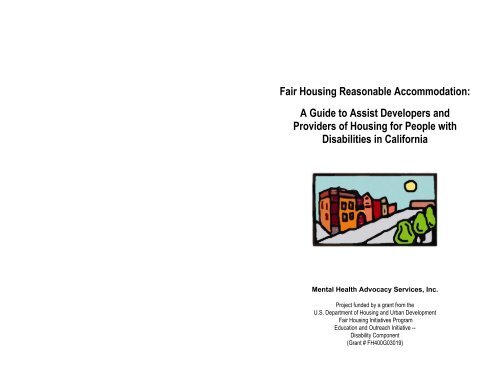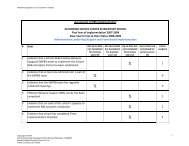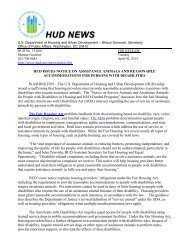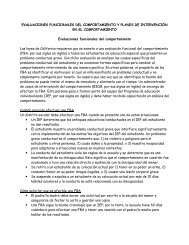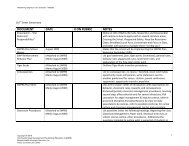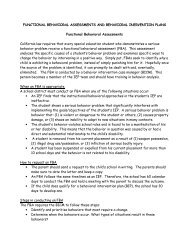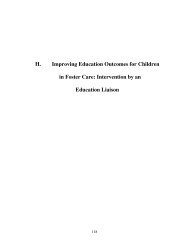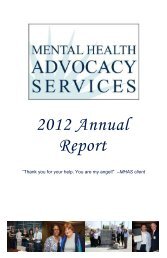Fair Housing Reasonable Accommodation Laws: - Mental Health ...
Fair Housing Reasonable Accommodation Laws: - Mental Health ...
Fair Housing Reasonable Accommodation Laws: - Mental Health ...
Create successful ePaper yourself
Turn your PDF publications into a flip-book with our unique Google optimized e-Paper software.
<strong>Fair</strong> <strong>Housing</strong> <strong>Reasonable</strong> <strong>Accommodation</strong>:<br />
A Guide to Assist Developers and<br />
Providers of <strong>Housing</strong> for People with<br />
Disabilities in California<br />
<strong>Mental</strong> <strong>Health</strong> Advocacy Services, Inc.<br />
Project funded by a grant from the<br />
U.S. Department of <strong>Housing</strong> and Urban Development<br />
<strong>Fair</strong> <strong>Housing</strong> Initiatives Program<br />
Education and Outreach Initiative --<br />
Disability Component<br />
(Grant # FH400G03019)
16<br />
17<br />
MENTAL HEALTH ADVOCACY SERVICES, INC.<br />
<strong>Mental</strong> <strong>Health</strong> Advocacy Services, Inc. (MHAS) is a private, non-profit public interest law<br />
office that has provided legal services to people with mental and developmental<br />
disabilities since 1977. In addition to assisting individual clients, MHAS serves as a<br />
resource to the community by providing training and technical assistance to consumers,<br />
advocates, and attorneys, as well as public and private agencies.<br />
One of MHAS’ priorities is to increase access to housing for people with disabilities. A<br />
primary focus of MHAS’ fair housing advocacy is helping non-profit developers overcome<br />
barriers to the development of critically needed affordable housing. MHAS has worked<br />
with affordable housing developers in almost every phase of the project approval<br />
process, from attending meetings with planning officials to developing fair housing<br />
educational materials to address neighborhood opposition.<br />
This guide was developed as part of MHAS’ 2004-05 “Getting It Built” project, which was<br />
funded by a grant from the U.S. Department of <strong>Housing</strong> & Urban Development’s <strong>Fair</strong><br />
<strong>Housing</strong> Initiatives Program. The project has provided fair housing training and technical<br />
assistance to affordable housing developers and other organizations involved in the<br />
development of housing for people with disabilities in seven southern California counties:<br />
Los Angeles, Orange, Riverside, San Diego, Santa Barbara, Ventura and Fresno<br />
Counties.<br />
TABLE OF CONTENTS<br />
INTRODUCTION ................................................................................................................ 1<br />
FAIR HOUSING LAWS PROTECT THE DEVELOPMENT AND USE OF HOUSING FOR<br />
PEOPLE WITH DISABILITIES .............................................................................................. 2<br />
The Law Prohibits Discriminatory Land Use and Zoning Regulations<br />
that Deny <strong>Housing</strong> Opportunities to People with Disabilities ................................ 2<br />
Proving Discrimination Under <strong>Fair</strong> <strong>Housing</strong> <strong>Laws</strong> ................................................. 3<br />
DEVELOPERS AND PROVIDERS OF HOUSING FOR PEOPLE WITH DISABILITIES MAY<br />
SEEK REASONABLE ACCOMMODATIONS TO OVERCOME LAND USE AND ZONING<br />
RESTRICTIONS ................................................................................................................ 5<br />
Local Governments Must Make <strong>Reasonable</strong> <strong>Accommodation</strong>s in Their<br />
Land Use and Zoning Regulations for <strong>Housing</strong> for People with Disabilities ......... 5<br />
The <strong>Reasonable</strong> <strong>Accommodation</strong> Analysis: How Requests Will Be<br />
Evaluated .............................................................................................................. 6<br />
Developers and Providers Should Seek <strong>Reasonable</strong> <strong>Accommodation</strong>s<br />
Instead of Using Existing Entitlement Procedures ................................................ 8<br />
<strong>Mental</strong> <strong>Health</strong> Advocacy Services, Inc.<br />
How to Make a Request for <strong>Reasonable</strong> <strong>Accommodation</strong> if the Local<br />
3255 Wilshire Blvd., Suite 902<br />
Government Does Not Have a Written Procedure for Doing So ......................... 10<br />
Los Angeles, CA 90010 EXAMPLES OF REASONABLE ACCOMMODATIONS IN LAND USE AND ZONING ...................... 11<br />
(213) 389-2077<br />
www.mhas-la.org<br />
REASONABLE ACCOMMODATION UNDER THE AMERICANS WITH DISABILITIES ACT ............. 14<br />
FINAL THOUGHTS .......................................................................................................... 14<br />
This guide may not be reproduced, in whole or in part, without appropriate<br />
attribution to <strong>Mental</strong> <strong>Health</strong> Advocacy Services, Inc.<br />
ENDNOTES .................................................................................................................... 15<br />
LETTER OF CALIFORNIA ATTORNEY GENERAL BILL LOCKYER SUPPORTING<br />
REASONABLE ACCOMMODATION PROCEDURES ............................................................... 17<br />
February 2005
16 17<br />
INTRODUCTION<br />
Despite over a decade of progress in fighting unlawful discrimination, today affordable<br />
housing developers face many challenges in getting housing for people with disabilities<br />
built. All too often, one of the most significant challenges is overcoming local land use<br />
and zoning regulations and practices that restrict or even prohibit the development and<br />
siting of housing for people with disabilities. Likewise, housing providers who wish to use<br />
existing housing in residential zones that is appropriate for people with disabilities are<br />
also frequently restricted by local regulations that impede such a use.<br />
This guide has been prepared for those who develop or provide affordable housing for<br />
people with disabilities to explain how fair housing laws can be used to overcome<br />
restrictive local land use and zoning regulations. <strong>Fair</strong> housing laws, particularly the<br />
reasonable accommodation provisions, have often been overlooked by developers and<br />
providers as a way of remedying obstacles in the provision of housing. First, the guide<br />
provides an overview of fair housing laws, explaining how these civil rights laws protect<br />
people with disabilities in housing and, more specifically, how housing developers and<br />
providers can use the reasonable accommodation provisions of the law in getting their<br />
housing built. Next, the guide explains how housing developers and providers should<br />
make requests for reasonable accommodations and the legal basis by which local<br />
governments should evaluate those requests. Lastly, the guide offers some examples of<br />
the reasonable accommodations that housing developers and providers may need and,<br />
based on case law, have a likelihood of obtaining from local government.
16 2 17 3<br />
FAIR HOUSING LAWS PROTECT THE DEVELOPMENT AND USE OF HOUSING FOR<br />
PEOPLE WITH DISABILITIES<br />
The Law Prohibits Discriminatory Land Use and Zoning Regulations that Deny<br />
<strong>Housing</strong> Opportunities to People with Disabilities<br />
The federal <strong>Fair</strong> <strong>Housing</strong> Amendments Act of 1988 (the Act) makes it illegal to<br />
discriminate in housing against individuals based on their race, color, religion, gender,<br />
national origin, familial status (families with children) or disability. 1 The Act prohibits local<br />
governments from making housing opportunities unavailable to people with disabilities<br />
through discriminatory land use and zoning rules, polices, practices and procedures.<br />
The legislative history of the Act recognizes that zoning code provisions have<br />
discriminated against people with disabilities by limiting opportunities to live in the<br />
community in congregate or group living arrangements.<br />
While state and local governments have authority to protect safety<br />
and health and to regulate use of land, that authority has sometimes<br />
been used to restrict the ability of individuals to live in communities.<br />
This has been accomplished by such means as the enactment or<br />
imposition of . . . land use requirements on congregate living<br />
arrangements among non-related persons with disabilities. Since<br />
these requirements are not imposed on families and groups of similar<br />
size of other unrelated people, these requirements have the effect of<br />
discriminating against people with disabilities. 2<br />
(Emphasis added.)<br />
A person with a disability is someone who has a physical<br />
or mental impairment that limits a major life activity; has a<br />
record of such impairment; or is regarded as having such<br />
an impairment. 3 People in recovery for substance abuse<br />
are also protected by fair housing laws; however, current<br />
users of illegal controlled substances are not protected by<br />
fair housing laws unless they have a separate disability. 4<br />
California’s own fair housing statute, the <strong>Fair</strong> Employment and <strong>Housing</strong> Act (FEHA),<br />
prohibits discrimination on the same bases as federal law and also four additional bases:<br />
marital status, ancestry, sexual orientation and source of income. 5 The FEHA explicitly<br />
prohibits discriminatory “public or private land use practices, decisions and<br />
authorizations” including, but not limited to, “zoning laws, denials of permits, and other<br />
[land use] actions . . . that make housing opportunities unavailable” to people with<br />
disabilities. 6 In enacting state fair housing laws, the California Legislature made the<br />
following findings, which recognized that land use practices have discriminated against<br />
group living arrangements for individuals with disabilities:<br />
a. That public and private land use practices, decisions, and<br />
authorizations have restricted, in residentially zoned areas,<br />
the establishment and operation of group housing, and other<br />
uses.<br />
b. That people with disabilities . . . are significantly more likely<br />
than other people to live with unrelated people in group<br />
housing.<br />
c. That this act covers unlawful discriminatory restrictions<br />
against group housing for these people. 7<br />
The protections afforded people with disabilities also extend to those associated with<br />
them. Providers and developers of housing for people with disabilities have “standing” to<br />
file a court action alleging a violation under either federal or state fair housing laws or<br />
seek administrative relief from a federal agency (U.S. Department of <strong>Housing</strong> and Urban<br />
Development) or state agency (California Department of <strong>Fair</strong> Employment and <strong>Housing</strong>).<br />
The federal <strong>Fair</strong> <strong>Housing</strong> Amendments Act is much broader than other civil rights laws in<br />
that anyone suffering a “distinct and palpable injury” as the result of another’s<br />
discriminatory act may sue. The injured party does not need to be the target of<br />
discrimination. 8 Thus, persons prevented from providing housing for individuals with<br />
disabilities because of a municipality’s discriminatory acts have standing to sue under the<br />
Act or FEHA. 9<br />
Proving Discrimination Under <strong>Fair</strong> <strong>Housing</strong> <strong>Laws</strong><br />
The federal Act and California’s FEHA prohibit both intentional discrimination and zoning<br />
rules and regulations that have the effect of discriminating against housing for people<br />
with disabilities. This two-pronged basis is particularly important in relation to the<br />
development and use of housing for people with disabilities. In many instances, zoning<br />
regulations that are facially neutral have an adverse impact that results in the denial of<br />
housing opportunities to people with disabilities.
16 4 17 5<br />
Intentional Discrimination -<br />
When a local government’s land<br />
use or zoning code illegally singles<br />
out and treats housing for people<br />
with disabilities in an adverse<br />
manner, it is intentionally<br />
discriminating.<br />
When a local government’s land use or zoning<br />
code illegally singles out and treats housing for<br />
people with disabilities in an adverse manner,<br />
it is intentionally discriminating. For example,<br />
a zoning provision that specifically prohibits the<br />
development of group homes for people with<br />
disabilities in single family residential zones is<br />
discriminatory on its face. To prove<br />
discriminatory intent, an individual need only show that disability was one of the factors<br />
considered by the city or county in making a land use or zoning decision. 10 Intentional<br />
discrimination may include actions or decision-making that is motivated by stereotypes,<br />
prejudices, unfounded fears or misperceptions about people with disabilities. Elected<br />
officials that adopt the discriminatory animus of neighborhoods or communities may face<br />
liability under fair housing laws. 11<br />
Discriminatory Effect -<br />
Discrimination may also be<br />
established by proving that a<br />
particular practice has a<br />
disparate impact on people with<br />
disabilities. Discriminatory intent<br />
need not be proven.<br />
Discrimination may also be established by<br />
proving that a particular practice has a disparate<br />
impact on people with disabilities. Discriminatory<br />
intent need not be proven. Effect, not motivation,<br />
is the touchstone. 12 For example, a zoning<br />
ordinance limiting the number of unrelated<br />
persons that may reside together in a single<br />
family residential zone through a restrictive<br />
definition of “family,” without singling out any<br />
particular group, has the effect of discriminating against people with disabilities who<br />
frequently live together in congregate living arrangements.<br />
Both of the foregoing examples of zoning regulations are illegal under fair housing laws<br />
because, either intentionally, or in effect, the restrictions deny housing opportunities to<br />
people with disabilities. While case law has established that a federal fair housing law<br />
violation may be proven through disparate impact, California law has codified that a<br />
victim may establish liability solely on the basis of discriminatory effect. 13 Land use and<br />
zoning regulations that are intentionally discriminatory must be eliminated from a local<br />
zoning code; a city or county may be liable if it continues to rely on provisions that violate<br />
fair housing laws. Local governments should also remove from their zoning code<br />
regulations that have an adverse or disparate impact on housing for people with<br />
disabilities. However, for developers and providers of housing for people with disabilities<br />
who need to move forward on a particular project, often the most expedient method is to<br />
seek a reasonable accommodation. Nevertheless, an offer of reasonable<br />
accommodation will not cure an intentionally discriminatory zoning regulation. 14<br />
DEVELOPERS AND PROVIDERS OF HOUSING FOR PEOPLE WITH DISABILITIES MAY<br />
SEEK REASONABLE ACCOMMODATIONS TO OVERCOME LAND USE AND ZONING<br />
RESTRICTIONS<br />
Local Governments Must Make <strong>Reasonable</strong> <strong>Accommodation</strong>s in Their Land Use<br />
and Zoning Regulations for <strong>Housing</strong> for People with Disabilities<br />
In addition to not discriminating against people with disabilities, under both federal and<br />
state fair housing laws cities and counties have an affirmative duty to provide<br />
reasonable accommodation in land use and zoning rules, policies, practices and<br />
procedures where it may be necessary to provide individuals with disabilities equal<br />
opportunity in housing. 15 While fair housing laws intend that all people have equal<br />
access to housing, the law also recognizes that people with disabilities may need extra<br />
tools to achieve equality. <strong>Reasonable</strong> accommodation is one of the tools that is intended<br />
to further housing opportunities for people with disabilities.<br />
For developers and providers of housing for people with disabilities who are often<br />
confronted with siting or use restrictions, reasonable accommodation provides a means<br />
of requesting from the local government flexibility in the application of land use and<br />
zoning regulations or, in some instances, even a waiver of certain restrictions or<br />
requirements because it is necessary to achieve equal access to housing. 16 Cities and<br />
counties are required to consider requests for accommodations related to housing for<br />
people with disabilities and provide the accommodation when it is determined to be<br />
“reasonable” based on fair housing laws and the case law interpreting the statutes.<br />
Examples of reasonable accommodations involving land use, zoning and<br />
building requirements:<br />
• A special needs housing developer wishes to develop a 12-unit multi-family building<br />
in a low density commercial zone, bordered by a residential district, because the<br />
property is within close proximity to the mental health services which will be used by<br />
the residents with disabilities. The developer seeks a waiver of the prohibition<br />
against residential uses in commercial zones.<br />
• A housing provider or developer seeks from its local government waiver of a<br />
residential fence height restriction so that many of the residents of the home, who<br />
because of their mental disabilities fear unprotected spaces, may use the backyard.<br />
• A housing provider requests deviation from the code for installation of a wheelchair<br />
ramp at an existing home that will be used by people with disabilities.
16 6 177<br />
The <strong>Reasonable</strong> <strong>Accommodation</strong> Analysis: How Requests Will Be Evaluated<br />
A statutorily based four-part analysis is used in evaluating requests for reasonable<br />
accommodation related to land use and zoning matters and is incorporated in those<br />
reasonable accommodation procedures which have been adopted thus far by California<br />
jurisdictions. This analysis gives great weight to furthering the housing needs of people<br />
with disabilities and also considers the impact or effect of providing the requested<br />
accommodation on the City and its overall zoning scheme. Developers and providers of<br />
housing for people with disabilities must be ready to address each element of the<br />
following four-part analysis.<br />
<strong>Housing</strong> developers and providers<br />
have obtained accommodations to<br />
increase the number of residents<br />
based on economic necessity, but<br />
a court would require very specific<br />
evidence that the number of<br />
residents proposed for the housing<br />
was necessary to make the project<br />
economically viable.<br />
each request is evaluated based on the<br />
particular set of facts. 20 For example, housing<br />
developers and providers have obtained<br />
accommodations to increase the number of<br />
residents based on economic necessity but, as<br />
discussed in the Examples section (see page<br />
11), a court would require very specific<br />
evidence that the number of residents<br />
proposed for the housing was necessary to<br />
make the project economically viable.<br />
• The housing that is the subject of the request for reasonable<br />
accommodation is for people with disabilities as defined in federal or<br />
state fair housing laws;<br />
• The reasonable accommodation requested is necessary to make<br />
specific housing available to people with disabilities who are protected<br />
under fair housing laws;<br />
• The requested accommodation will not impose an undue financial or<br />
administrative burden on the local government; and<br />
• The requested accommodation will not result in a fundamental<br />
alteration in the local zoning code.<br />
Initially, developers and providers of housing for people with disabilities must establish<br />
that the housing is specifically for people with disabilities. In most instances, this<br />
threshold requirement can be met by describing generally the use of the dwelling, such<br />
as licensed residential care facility, home for transitional age youth with disabilities, or<br />
sober living home for those in recovery. An applicant seeking a reasonable<br />
accommodation is not required to identify the nature or severity of the disabilities of the<br />
residents. 17 In California, housing developers and providers should rely on the FEHA<br />
definition of “disability” because it is more inclusive than the federal Act definition. 18<br />
Second, the accommodation sought must be necessary to make the specific housing<br />
available to people with disabilities. To establish that the accommodation is necessary, it<br />
must be shown that, without the accommodation, people with disabilities will be denied<br />
the equal opportunity to live in a residential neighborhood. 19 In other words, “but for the<br />
accommodation,” the housing would not be available and a housing opportunity for<br />
people with disabilities would be denied. Determining whether an accommodation is<br />
necessary entails a “fact specific inquiry regarding each such request,” meaning that<br />
Once a developer or housing provider establishes protection under the law and that the<br />
requested accommodation is necessary, then the accommodation must be provided<br />
unless the local government presents persuasive evidence that doing so would either<br />
create an undue burden or result in a fundamental alteration of the zoning code.<br />
Establishing either of these burdens makes the accommodation “unreasonable” and is<br />
the basis for denying the requested accommodation. As for “undue burden,” in the land<br />
use and zoning context many requests for accommodation will be requests to modify or<br />
waive a regulation or procedure. It costs a jurisdiction nothing to a waive a rule, meaning<br />
that “ . . . the accommodation amounts to nothing more than a request for nonenforcement<br />
of a rule.” In those instances, a city would not be likely to demonstrate<br />
undue burden. 21<br />
In addition to not imposing an undue financial or administrative burden, a reasonable<br />
accommodation must also not result in the fundamental alteration in the nature of a<br />
program. 22 In the land use and zoning context, “fundamental alteration in the nature of<br />
the program” means an alteration so far-reaching that it would change the essential<br />
zoning scheme of a municipality. The courts have generally held that the granting of an<br />
exception for one dwelling that provides housing for people with disabilities does not<br />
change the residential character of a neighborhood and therefore does not result in a<br />
fundamental alteration in the nature of a program. 23<br />
In those instances in which a local government intends to deny a requested<br />
accommodation because it would be a burden or result in a fundamental alteration, it is<br />
appropriate for the jurisdiction to engage in an “interactive process” (a requisite in<br />
employment discrimination cases) and propose an alternative accommodation that could<br />
achieve a comparable result. While the case law is unclear as to whether a local<br />
government is required to do so, in practice local governments often negotiate an<br />
alternative accommodation. 24
16 8 17 9<br />
Developers and Providers Should Seek <strong>Reasonable</strong> <strong>Accommodation</strong>s Instead of<br />
Using Existing Entitlement Procedures<br />
Today, many local governments have yet to adopt fair housing reasonable<br />
accommodation procedures, and they continue to instruct developers and housing<br />
providers that exceptions to land use or zoning regulations are provided through a<br />
conditional use permit or variance process. There are a number of reasons why<br />
developers and providers of housing for people with disabilities should not use existing<br />
entitlement procedures when they need to deviate from land use and zoning regulations.<br />
The first reason that existing entitlement procedures should be rejected is that both the<br />
conditional use permit and variance processes involve a public notice and hearing which<br />
often creates a forum for neighborhood opposition that may unduly influence decisionmakers.<br />
And, a number of courts have held that a fair housing reasonable<br />
accommodation is not provided by requiring a developer or provider of housing for<br />
people with disabilities to submit to a conditional use permit or variance process. Going<br />
through such a process has a discriminatory effect because it requires a public notice<br />
and hearing that can stigmatize prospective residents with disabilities. 25 The courts have<br />
also recognized that the variance process is lengthy, costly and burdensome. 26<br />
Developers and providers of housing for people with disabilities know well that the public<br />
nature of the conditional use permit and variance process can be a catalyst for<br />
organizing opposition, and NIMBY sentiments can delay or even stop the development or<br />
siting of housing for people with disabilities. Strong opposition can persuade an elected<br />
official to vote against a housing project or lead a developer or housing provider to<br />
abandon a project because of the hostility that future residents with disabilities will have<br />
to face in the neighborhood. A reasonable accommodation procedure is unlikely to have<br />
the degree of public notification and hearing process that is found in virtually all<br />
entitlement procedures.<br />
The second reason that existing conditional use permit and variance processes should<br />
be avoided is that both entitlement procedures apply the wrong standard in determining<br />
whether to grant or deny the requested relief. Issuance of a conditional use permit<br />
requires a determination that the proposed use will not be materially detrimental to the<br />
character of the immediate neighborhood and that it will be in harmony with the various<br />
elements and objectives of the local government’s General Plan. Equally problematic<br />
from a fair housing perspective is that a local government may impose any conditions on<br />
the use of the property that are deemed necessary to ensure this compatibility.<br />
To obtain a variance, an applicant must make a showing of “hardship” based on certain<br />
unique physical characteristics of the subject property. In contrast, a request for<br />
reasonable accommodation must establish that relief from the zoning code is necessary<br />
for individuals with disabilities to have equal access to use and enjoy housing. A<br />
jurisdiction cannot comply with its duty to provide reasonable accommodation if it applies<br />
a standard that looks at the physical characteristics of the property instead of considering<br />
need based on the disabilities of the residents of the housing.<br />
In a fair housing reasonable accommodation procedure, once an applicant establishes<br />
that the accommodation is necessary to overcome barriers related to disability, the<br />
request should be granted unless a jurisdiction can demonstrate that the accommodation<br />
will impose an undue financial or administrative burden on the jurisdiction or that the<br />
accommodation will result in a fundamental alteration of the local zoning code. These<br />
two factors require that the city or county demonstrate that the requested<br />
accommodation is “unreasonable.” In the variance process, the focus is shifted away<br />
from the needs of people with disabilities. The local government will determine whether<br />
granting the variance will be “materially detrimental to the public welfare, or injurious to<br />
the property or improvements in the same zone or vicinity in which the property is<br />
located.” In a reasonable accommodation procedure, the possible adverse impacts in<br />
the surrounding areas cannot defeat the needs of the people with disabilities to have<br />
access to housing.<br />
In May 2001, California’s Attorney<br />
General, Bill Lockyer, sent a letter<br />
to every California city and county,<br />
encouraging them to amend their<br />
zoning ordinances to add a<br />
procedure for handling requests for<br />
reasonable accommodations made<br />
pursuant to state and federal fair<br />
housing laws.<br />
The importance of local governments adopting<br />
reasonable accommodation procedures for<br />
local land use and zoning regulations received<br />
statewide attention in May 2001 from<br />
California’s Attorney General, Bill Lockyer. Mr.<br />
Lockyer sent a letter to the mayor of every<br />
California city and the president of every<br />
county board of supervisors, encouraging them<br />
to amend their zoning ordinances to add a<br />
procedure for handling requests for reasonable<br />
accommodations made pursuant to state and federal fair housing laws. The Attorney<br />
General counsels against exclusive reliance on existing variance or conditional use<br />
permit procedures for handling requests for reasonable accommodations because they<br />
do not use fair housing legal standards, and, furthermore, local jurisdictions have an<br />
affirmative duty to provide reasonable accommodation. The Attorney General also<br />
recognizes that community opposition is invited through a conditional use permit process,<br />
and such opposition is often grounded in stereotypical assumptions about people with<br />
disabilities and unfounded concerns about the impact of such housing on surrounding<br />
property values. A copy of the Attorney General’s letter is included at the end of this<br />
guide (see page 17).
16 10 17 11<br />
How to Make a Request for <strong>Reasonable</strong> <strong>Accommodation</strong> if the Local Government<br />
Does Not Have a Written Procedure for Doing So<br />
Local governments have an affirmative duty to consider requests for reasonable<br />
accommodation regardless of whether they have a written procedure in place for making<br />
such a request. Initially, an inquiry should be made to the local government’s planning<br />
department to determine whether there is an established procedure for seeking an<br />
accommodation. If there is not a written procedure, then the request for reasonable<br />
accommodation should be made in writing. A developer or provider of housing for<br />
people with disabilities requesting a reasonable accommodation must be prepared to<br />
address each of the points of analysis set forth above.<br />
It is highly recommended that,<br />
should a local government<br />
assert that a developer or<br />
provider must make a request<br />
for reasonable accommodation<br />
within an entitlement process, an<br />
attorney knowledgeable about<br />
fair housing laws should be<br />
consulted to protect both the<br />
developer’s and residents’<br />
rights.<br />
While directly requesting a reasonable<br />
accommodation is the recommended approach,<br />
some local governments may assert that the<br />
request for reasonable accommodation will be<br />
considered only within the established<br />
entitlement procedure or only after a<br />
determination has been made on the variance or<br />
conditional use permit. Although fair housing<br />
advocates and attorneys do not believe this is the<br />
legally correct position to take, the case law is<br />
unsettled in this area. Therefore, it is highly<br />
recommended that, should a local government<br />
assert that a developer or provider must make a<br />
request for reasonable accommodation within an entitlement process, an attorney<br />
knowledgeable about fair housing laws should be consulted to protect both the<br />
developer’s and residents’ rights.<br />
EXAMPLES OF REASONABLE ACCOMMODATIONS IN LAND USE AND ZONING<br />
Many developers and providers of housing for people with disabilities will want to request<br />
an accommodation to overcome local zoning code provisions that restrict the siting and<br />
use of housing for people with disabilities in low density residential zones based on the<br />
number of residents in the home. There are also many other accommodations that may<br />
be appropriate including, for example, a reduction in the number of parking spaces<br />
required for a development, or waiver of regulations related to the physical structure of a<br />
dwelling or yard area.<br />
The following examples represent some of the more likely accommodations that<br />
developers and providers may need for housing for people with disabilities. This is not<br />
an exhaustive list; many other exceptions to land use and zoning regulations may be<br />
needed depending on the particular housing. The case authority provided for many of<br />
the examples involves variances or conditional use permits because no reasonable<br />
accommodation procedure existed in the jurisdiction at the time the matter was litigated.<br />
In some instances, housing providers requested a reasonable accommodation within a<br />
variance process.<br />
Increasing the Number of Residents in <strong>Housing</strong> for People with Disabilities<br />
Both developers and providers of housing for people with disabilities may need a<br />
reasonable accommodation from a local government to site or use housing for people<br />
with disabilities in a single family or other low density residential zone. Despite federal<br />
and state fair housing laws and California case law, some local governments continue to<br />
use an illegal definition of “family” that distinguishes between related and unrelated<br />
individuals and limits the number of unrelated persons that may reside together to<br />
constitute a “family.” While not singling out people with disabilities on its face, such a<br />
definition may have a disparate impact on housing for people with disabilities because it<br />
effectively restricts the number of unrelated persons with disabilities who may reside<br />
together in single family and other low density residential zones. 27<br />
The case law supports granting reasonable accommodation to overcome a restrictive<br />
definition of “family” so that people with disabilities can live together in a group home<br />
setting in a single family or other low density residential zone. 28 A developer or provider<br />
must establish that, without the accommodation, people with disabilities will be denied<br />
equal opportunity to live in a residential neighborhood. 29 The courts have held that a<br />
reasonable accommodation that results in an increase in the number of residents at a<br />
home does not result in an undue burden on the local government, nor does it undermine<br />
the residential character of the neighborhood or the local zoning scheme. 30
16 12 17 13<br />
The courts have granted increases in the number of residents at a home or permitted a<br />
home to exceed the number of unrelated persons living together in single family<br />
residential zones based on “economic necessity.” 31 A housing provider must establish<br />
through budgets, including income and expense accountings, that his or her home must<br />
have a certain number of residents to be financially sound; “conclusory allegations<br />
without evidence are insufficient to support an increase in the number of residents based<br />
on economic viability.” 32 The financial necessity argument has been unsuccessful where<br />
the increase requested is great (i.e., a doubling in the number of residents) or the<br />
housing already has a large number of residents. 33<br />
The courts have<br />
recognized that an<br />
increased number of<br />
people residing in a<br />
home may be necessary<br />
for therapeutic purposes.<br />
Extending the Footprint of the <strong>Housing</strong><br />
A housing developer or provider may also seek a<br />
reasonable accommodation to increase the number of<br />
residents for therapeutic purposes. The courts have<br />
recognized that, for therapeutic purposes, an increased<br />
number of people residing in a home may be necessary<br />
for a congregate or group living arrangement to<br />
effectively assist people with disabilities. 34<br />
A reasonable accommodation request may seek waiver of land use or zoning restrictions<br />
that, for aesthetic reasons or to preserve homeowners’ views, impose a limit on the<br />
footprint of a dwelling in relation to lot size. A housing developer or provider may need to<br />
increase the footprint of a dwelling to make the interior accessible to wheelchair users<br />
who will reside at the premises. Whether the accommodation will be granted depends on<br />
the particular facts of the case analyzed under the factors set forth above.<br />
Relief From Side Yard Requirements<br />
A developer may seek changes related to side yard and backyard zoning code<br />
requirements or substitution of side yard footage for rear yard footage, and it is unlikely to<br />
be considered either an undue burden or fundamental alteration. 35 This type of<br />
accommodation may be necessary to install ramps to meet the needs of persons with<br />
disabilities who use wheelchairs.<br />
will also likely compare the requested fence height to other fences within the same block,<br />
as well as emergency access to the premises. A housing provider should be prepared to<br />
address these concerns when seeking a waiver of a fence height requirement.<br />
Reduction in Parking Requirements<br />
<strong>Housing</strong> developers and providers may seek a reduction in the number of parking spaces<br />
required at housing for people with disabilities based on the number of residents who<br />
drive or have cars. 36 While some local governments have standardized a procedure for<br />
seeking a parking reduction, it is recommended that those developing or providing<br />
housing for people with disabilities seek an exception through a reasonable<br />
accommodation request. Local governments have a statutory duty to provide a<br />
reasonable accommodation, and the applicant should not be required to submit to a<br />
public process.<br />
Waiver of Concentration and Dispersal Rules<br />
The concerns of neighbors<br />
based on stereotypes about<br />
people with disabilities are<br />
not a legal basis for<br />
defeating a request for<br />
accommodation of this type<br />
or any other.<br />
Many local governments continue to have regulations<br />
that seek to disperse group homes to avoid<br />
“overconcentration” of housing for people with<br />
disabilities in particular neighborhoods. The State of<br />
California requires that licensed residential care<br />
facilities be separated by a distance of 300 feet.<br />
However, local governments may waive this distance<br />
requirement and permit these licensed homes to be in<br />
closer proximity. 37 While some states’ spacing<br />
requirement rules have been struck down as illegal under fair housing laws because they<br />
imposed too great a separation (i.e., 1,500 feet), California’s restriction has not been<br />
challenged. The courts have waived dispersal requirements as an accommodation<br />
where it was determined to be reasonable and not burdensome to a municipality. The<br />
concerns of neighbors based on stereotypes about people with disabilities are not a legal<br />
basis for defeating a request for accommodation of this type or any other. 38<br />
Fence Height Restrictions<br />
<strong>Housing</strong> providers have been granted exceptions to fence height restrictions when<br />
greater privacy was necessary for a person with a disability to use and enjoy the<br />
outdoors at a residence. In reviewing a request for reasonable accommodation related<br />
to a height restriction, the local government must consider the need of the applicant but
14 16<br />
17 15<br />
REASONABLE ACCOMMODATION UNDER THE AMERICANS WITH DISABILITIES ACT<br />
Developers and providers of non-residential services, including mental health treatment<br />
programs or multi-service centers for people with disabilities, may obtain reasonable<br />
accommodations under the Americans with Disabilities Act. <strong>Fair</strong> housing laws provide<br />
protections to residential dwellings and generally do not cover non-residential programs.<br />
Title II of the Americans with Disabilities Act (ADA) prohibits discrimination against<br />
individuals with disabilities by state and local governments, including the programs and<br />
services offered by a jurisdiction’s housing development, planning and zoning<br />
agencies. 39 The ADA has a broad scope and complements the federal <strong>Fair</strong> <strong>Housing</strong><br />
Amendments Act in covering certain non-traditional housing such as governmentoperated<br />
homeless shelters as well as social services offices and treatment programs<br />
serving people with disabilities. 40 Title II protects against discriminatory land use and<br />
zoning decisions made by local governments against development of these uses. In<br />
addition, entities associated with people with disabilities are protected from discrimination<br />
under the ADA.<br />
Title II of the ADA, like the <strong>Fair</strong> <strong>Housing</strong> Amendments Act, requires that local<br />
governments make reasonable modifications in “policies, practices, or procedures when<br />
the modifications are necessary to avoid discrimination on the basis of disability, unless<br />
the public entity can demonstrate that making modifications would fundamentally alter<br />
the nature of the service, program or activity.” 41 The ADA term “reasonable modification”<br />
is essentially synonymous with the fair housing phrase “reasonable accommodation.”<br />
The requirement that cities and counties make reasonable modification under Title II of<br />
the ADA means that those who develop and provide non-residential treatment programs<br />
to people with disabilities, either associated with or independent of housing, may seek<br />
modifications under Title II of the ADA to ensure equal opportunity for participation in<br />
programs and activities.<br />
FINAL THOUGHTS<br />
This guide has been prepared to inform developers and providers of the fair housing laws<br />
that protect housing for people with disabilities and to encourage them to seek<br />
reasonable accommodations from their local governments when such accommodations<br />
are necessary to ensure equal access to housing. While this general guide provides an<br />
overview of the law, it is not a substitute for specific legal advice, which is often<br />
necessary when faced with obstacles to developing or providing housing for people with<br />
disabilities. We encourage those faced with housing development challenges to seek<br />
legal counsel knowledgeable of fair housing laws early on so that they may most<br />
effectively use the law to overcome obstacles to developing or providing housing to<br />
people with disabilities.<br />
ENDNOTES<br />
1<br />
42 U.S.C. §§ 3601 et seq.<br />
2<br />
H.R. Rep. No 711, 100 th Cong., 2d Sess. 24 (1988), reprinted in 1988 U.S.C.C.A.N. 2173, 2185.<br />
3<br />
Cal. Gov’t. Code §§ 12955.3. While the federal Act requires a “substantial impairment,”<br />
California's more inclusive definition of disability is controlling in this state because federal law<br />
provides that nothing in the Act “shall be construed to invalidate or limit any law of the State that<br />
grants, guarantees, or protects the same rights as are granted by [the <strong>Fair</strong> <strong>Housing</strong> Act].” 42<br />
U.S.C.§ 3615.<br />
4<br />
42 U.S.C. § 3602(h); United States v. Southern Management Corp., 955 F.2d 914 (4 th Cir. 1992);<br />
Oxford House v. Town of Babylon, 819 F. Supp. 1179 (E.D.N.Y. 1993).<br />
5<br />
Cal. Gov’t. Code §§12900 et seq.<br />
6<br />
Cal. Gov’t. Code § 12955(l).<br />
7<br />
Stats. 1993 ch. 1277, § 18.<br />
8<br />
San Pedro Hotel Co. v. City of Los Angeles, 159 F.3d 470 (9 th Cir. 1998) (citing to Trafficante v.<br />
Metropolitan Life Ins. Co., 409 U.S. 205 (1972)).<br />
9<br />
Epicenter of Steubenville v. City of Steubenville, 924 F. Supp. 845 (S.D. Ohio 1996); Judy B. v.<br />
Borough of Tioga, 889 F. Supp. 792 (M.D. Pa 1995).<br />
10<br />
Oxford House-C v. City of St. Louis, 843 F. Supp. 1566 (E.D. Mo. 1994); Potomac Group<br />
Home Corp. v. Montgomery County, 823 F. Supp. 1285 (D.Md. 1993).<br />
11<br />
People Helpers Foundation, Inc. v. City of Richmond, 789 F. Supp. 725 (E.D. Va. 1992), 12 F.3d<br />
1321 (4 th Cir. 1993) (appeal as to damages); Assoc. Of Relatives & Friends of AIDS Patients v,<br />
Regs. & Permits Admin., 740 F. Supp. 95 (D.P.R. 1990).<br />
12<br />
Seivert v. Mill Valley, 1992 U.S. Dist. LEXIS 14727, (N.D. Cal.) (citing to Metropolitan <strong>Housing</strong><br />
Development Corp. v. Village of Arlington Heights, 558 F.2d 1283 (7 th Cir. 1977)); See also Martin<br />
v. Constance, 843 F. Supp. 1321 (E.D. Mo. 1994).<br />
13<br />
Cal. Gov’t. Code § 12955.8(b); Broadmoor San Clement Homeowners v. Nelson, 25 Cal. App.<br />
4 th 1 (4th Dist. 1994).<br />
14<br />
The Children's Alliance v. City of Bellevue, 950 F. Supp. 1491 (W.D. Wash. 1997); Hovsons Inc.<br />
v. Township of Brick, 89 F. 3d 1096 (3rd Cir. 1996); Bangerter v. Orem City Corp., 46 F. 3d 1491<br />
(10th Cir. 1995).<br />
15<br />
42 U.S.C. § 3604(f)(3)(B); Cal. Gov’t. Code § 12927(c)(1).<br />
16<br />
Turning Point, Inc. v. Caldwell, 74 F.3d 941 (9 th Cir. 1996).<br />
17<br />
Under both federal and state fair housing laws it is unlawful to make an inquiry of a person with a<br />
disability or one associated with him as to the nature or severity of the disability. 24 C.F.R.§<br />
100.202; Cal. Gov’t. Code § 12955 (b).<br />
18<br />
See Note 3, advising that the more inclusive definition of “disability” under FEHA should be relied<br />
upon.<br />
19<br />
City of Edmonds v. Wash. State Bldg. Code Council, 18 F.3d 802 (9 th Cir. 1994); Oconomowoc<br />
Residential Programs, Inc. v. City of Milwaukee, 300 F.3d 775 (7 th Cir. 2002).<br />
20<br />
U.S. v. California Mobile Home Park Management Co. (California Mobile Home I), 29 F.3d 1413<br />
(9 th Cir. 1994); Department of Justice Memorandum to National League of Cities (March 4, 1996).<br />
21<br />
Geibler v. M&B Assocs., 343 F. Supp. 1143 (9 th Cir. 2003) (rejecting the reasoning in<br />
Hemisphere Building Co. v. Village or Richton Park, 171 F.3d 437 (7 th Cir. 1999) and Salute v.<br />
Stratford Greens Garden Apartments, 136 F.3d 293 (2 nd Cir. 1998)).
16<br />
17<br />
22<br />
Southeastern Community College v. Davis, 442 U.S. 397, 99 S.Ct. 2361 (1979).<br />
23<br />
Smith & Lee Assocs. v. City of Taylor, 102 F.3d 781 (6 th Cir. 1996) (and related cases); Martin v.<br />
Constance, 843 F. Supp. 1321 (E.D. Mo. 1994); Oxford House v. Babylon, 819 F. Supp. 1179<br />
(E.D.N.Y. 1993).<br />
24<br />
Joint Statement of Department of <strong>Housing</strong> and Urban Development and Department of Justice:<br />
<strong>Reasonable</strong> <strong>Accommodation</strong> Under <strong>Fair</strong> <strong>Housing</strong> <strong>Laws</strong> (May 17, 2004) (available at<br />
www.hud.gov). At least one case, outside of the 9 th Circuit, has held that the interactive process is<br />
not required in reasonable accommodation determinations. Lapid-Laurel v. Zoning Board of<br />
Adjustment of Town of Scotch Plains, 284 F.3d 442 (3 rd Cir. 2002).<br />
25<br />
Stewart McKinney Foundation v. Town of <strong>Fair</strong>field, 790 F. Supp. 1197 (D.Conn. 1992); Horizon<br />
House Development Svcs. v. Township of Upper South Hampton, 804 F. Supp. 683 (E.D. Penn.<br />
1992).<br />
26<br />
Id.<br />
27<br />
In City of Santa Barbara v. Adamson, 27 Cal. 3d 123, 164 Cal. Rptr. 539 (1980), which preceded<br />
the enactment of federal and state fair housing laws, the California Supreme Court held that based<br />
on constitutionally guaranteed privacy rights, zoning code definitions of “family” cannot distinguish<br />
between related and unrelated individuals nor limit the number of unrelated persons that may<br />
reside together to constitute a “family.” <strong>Fair</strong> housing laws also hold that restrictive definitions of<br />
“family” have an adverse impact on housing for people with disabilities. See Oxford House Inc. v.<br />
Babylon, 819 F. Supp. 1179 (E.D. N.Y. 1993); Oxford House v. Township of Cherry Hill, 799 F.<br />
Supp 450 (D.N.J. 1992); United States v. Schuylkill Township, 1991 WL 117394 (E.D. Pa. 1990),<br />
reconsideration denied (E.D. Pa. 1991).<br />
28<br />
Dr. Gertrude A. Barber Center v. Peters Township, 273 F. Supp. 2d 643 (W.D. Penn. 2003).<br />
29<br />
Oconomowoc Residential Programs, Inc. v. City of Milwaukee, 300 F.3d 775 (7 th Cir. 2002).<br />
30<br />
U.S. v. Village of Marshall, 787 F. Supp. 872 (W.D. Wis. 1992); Oxford House-Evergreen v. City<br />
of Plainfield, 769 F. Supp. 1329 (D.N.J. 1991).<br />
31<br />
Geibeler v. M&B Assocs., supra, note 21, at 1152 (approving of Smith & Lee Assocs.v. City of<br />
Taylor, 102 F.3d 781 (6 th Cir. 1996)); See also Edmonds, supra, note 19, at 803-806.<br />
32<br />
Advocacy and Resource Center v. Town of Chazy, 62 F. Supp. 2d 686 (NYND 1999).<br />
33<br />
Town & Country Adult Living v. Village/Town of Mt. Kisko, 2003 WL 21219794 (SDNY).<br />
34<br />
Dr. Gertrude A. Barber Ctr., Inc. v. Peters Twp., 273 F. Supp. 2d 643 (W.D. Penn 2003); Lapid-<br />
Laurel v. Zoning Bd. Of Adjustments, 284 F.3d 442 (3 rd Cir. 2002); Brandt v. Village of Chebanse,<br />
82 F.3d 172 (7 th Cir. 1996).<br />
35<br />
U.S. v. City of Philadelphia, 838 F. Supp. 223 (E.D. Penn. 1993).<br />
36<br />
U.S. v. Commonwealth of Puerto Rico, 764 F. Supp. 220 (D.P.R. 1991).<br />
37<br />
California Community Care Facilities Act, <strong>Health</strong> & Safety Code § 1520.5.<br />
38<br />
Citizens for a Balanced City v. Plymouth Congregational Church, 672 N.W. 2d 13 (Minn. 2003);<br />
United States v. Marshall, 787 F. Supp. 872 (W.D. Wis. 1992).<br />
39<br />
42 U.S.C. § 12101 et seq.<br />
40<br />
Bay Area Addiction Research and Treatment, Inc. v. City of Antioch, 179 F.3d 725 (9 th Cir.<br />
1999).<br />
41<br />
28 C.F.R. § 35.130(b)(7)<br />
LETTER OF CALIFORNIA ATTORNEY GENERAL BILL LOCKYER<br />
SUPPORTING REASONABLE ACCOMMODATION PROCEDURES


